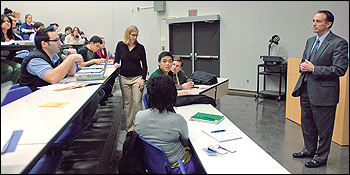Archives
Collins visits UB political science class
By LAUREN NEWKIRK MAYNARD
Reporter Contributor
Some students in a political science class got an insider's view of Erie County government yesterday, thanks to the personal connections of one of their classmates, who arranged for Erie County Executive Christopher C. Collins to visit their class.

Erie County
Executive Chris Collins talked about campaign strategy and his first 100
days in office with students in a first-year political science class
yesterday.
PHOTO: NANCY J. PARISI
Collins spent the first half of the class presenting the TV advertisements and campaign strategies that launched him into office, as well as his outlook on his administration’s first 100 days on the job.
Freshman Gregory Glauber has known the county leader for several years. Both are from Clarence and have been active in the Boy Scouts of America. An Eagle Scout and a former junior patrol officer for Collins’ scout troop, Glauber mentored Collins’ son, Cameron.
“I’m realizing how difficult scheduling can be in this new job, but I’ll always try to make room for Greg,” Collins said, citing his interest in committing some of his free time to community outreach. “I cancelled two meetings today to come to UB. Youth are our future, so I always try to make the effort to do this kind of thing.”
During the class, which is taught by Kristin Campbell, adjunct instructor in the Department of Political Science, Collins played a DVD of his campaign ads from last year and described the various strategies he used for each one. He touted the ads’ carefully planned timing and messaging as key to his success over opponents James Keane and Paul Clark.
“Early on, as a private-sector candidate, I knew I wasn’t well-recognized and I knew I had to redefine voters’ decisions about how they viewed the Republican Party,” he said.
Collins said he “began tilting at windmills” last April, hiring a consultant from Washington and bringing in the county’s first director of intergovernmental relations. “I didn’t take a course like Poli Sci 101” he told the large lecture hall, joking that instead he quickly learned how to talk with as many people as possible to gauge the public’s “bobblehead reaction”—an indication of whether they agreed with his positions.
Before he was elected Collins was sole investor and manager of Cobblestone Enterprises LLC, which bought out, managed and in some cases reopened several local companies, including Niagara Ceramics Corporation—formerly Buffalo China—and ZeptoMetrix, a biotech company. One of his best campaign ads featured testimonials from several employees of those businesses.
“I’ve been told that this ad is considered one of the best local campaign ads ever aired in this country,” Collins said. The more difficult ads to run were the negative ones attacking Keane and Clark, but he told the students “if you’re not prepared to put on the gloves and fight, you should get out of politics.”
What worked in the end, Collins said, was branding his campaign and defining himself through the “three Rs”: reform (county government), rebuild (the county’s economy) and reduce (taxes). His ad campaign also repeated his election theme: “It’s time for a chief executive, not a chief politician.”
After the presentation, students asked Collins questions ranging from taxes to the future of the Bills staying in Buffalo. They also inquired about a centralized Erie Community College and why he concentrated his campaign on the suburbs rather than the city. Answering the latter question, Collins said, “Eighty percent of this county’s $1.4 billion budget goes to Buffalo, so I like to illustrate my support through actions, not words.”
As for ECC, he maintains that centralization is a bad idea. “Proximity is a major concern for suburban students who are leaving the county to go to community colleges elsewhere.”
Collins also answered a question about his Six Sigma business management model, which he called the “cornerstone” of his election campaign. “Critics of this methodology have already been proved wrong. After several months in office, I now know that a corporate model like Six Sigma can work to reform government.”
He admitted that Six Sigma “seems odd to people because of its ninja-sounding green and black belts, but it has helped me reduce wasteful spending in my own companies, and I’m confident it will be the answer to implementing the three Rs.” Alfred Hammonds Jr., senior project director at UB’s Center for Industrial Effectiveness, has been appointed as the county’s Six Sigma director.
After class, Lauren M. Adornetto, a second-year transfer student from Clarence, said she doesn’t watch TV and didn’t closely follow the county election last year, so found the discussion of city versus suburban issues “enlightening.”
“Being from the suburbs, I travel downtown a lot for the arts and entertainment, so I appreciated his views on both,” she said.
Collins told the Reporter that he is “fully behind” the UB 2020 strategic plan and “very pleased and encouraged to be asked for my support.”
“This university is an important piece of a larger plan to encourage more economic growth in the county, and I’m very excited to hear about its expansion on its three campuses, including the Buffalo Niagara medical campus,” he said, adding that he hopes to lobby Albany for continued support for UB’s growth.
